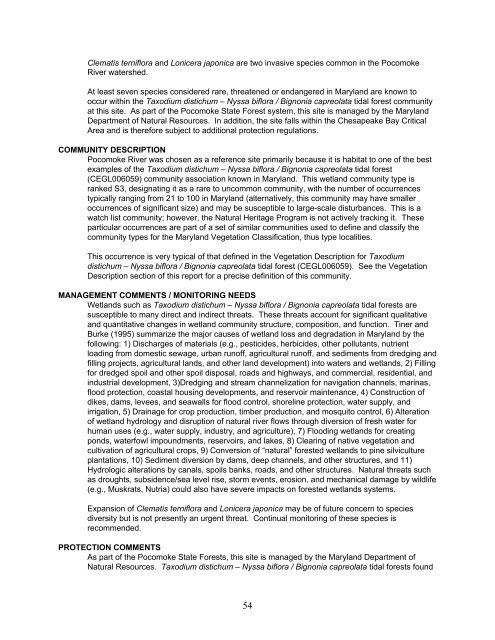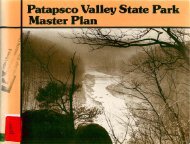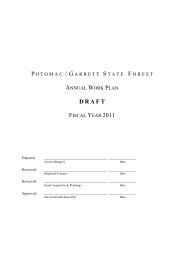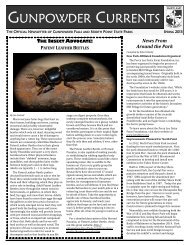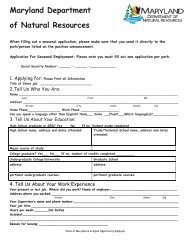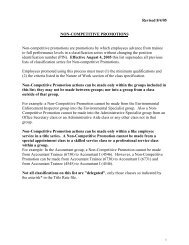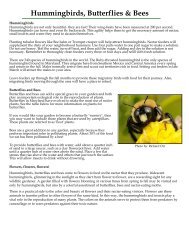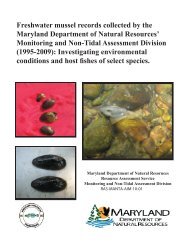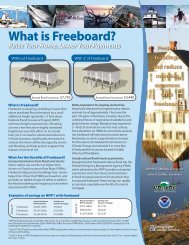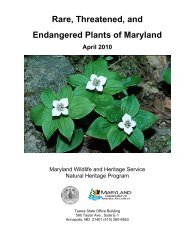tidal hardwood swamps - Maryland Department of Natural Resources
tidal hardwood swamps - Maryland Department of Natural Resources
tidal hardwood swamps - Maryland Department of Natural Resources
Create successful ePaper yourself
Turn your PDF publications into a flip-book with our unique Google optimized e-Paper software.
Clematis terniflora and Lonicera japonica are two invasive species common in the Pocomoke<br />
River watershed.<br />
At least seven species considered rare, threatened or endangered in <strong>Maryland</strong> are known to<br />
occur within the Taxodium distichum – Nyssa biflora / Bignonia capreolata <strong>tidal</strong> forest community<br />
at this site. As part <strong>of</strong> the Pocomoke State Forest system, this site is managed by the <strong>Maryland</strong><br />
<strong>Department</strong> <strong>of</strong> <strong>Natural</strong> <strong>Resources</strong>. In addition, the site falls within the Chesapeake Bay Critical<br />
Area and is therefore subject to additional protection regulations.<br />
COMMUNITY DESCRIPTION<br />
Pocomoke River was chosen as a reference site primarily because it is habitat to one <strong>of</strong> the best<br />
examples <strong>of</strong> the Taxodium distichum – Nyssa biflora / Bignonia capreolata <strong>tidal</strong> forest<br />
(CEGL006059) community association known in <strong>Maryland</strong>. This wetland community type is<br />
ranked S3, designating it as a rare to uncommon community, with the number <strong>of</strong> occurrences<br />
typically ranging from 21 to 100 in <strong>Maryland</strong> (alternatively, this community may have smaller<br />
occurrences <strong>of</strong> significant size) and may be susceptible to large-scale disturbances. This is a<br />
watch list community; however, the <strong>Natural</strong> Heritage Program is not actively tracking it. These<br />
particular occurrences are part <strong>of</strong> a set <strong>of</strong> similar communities used to define and classify the<br />
community types for the <strong>Maryland</strong> Vegetation Classification, thus type localities.<br />
This occurrence is very typical <strong>of</strong> that defined in the Vegetation Description for Taxodium<br />
distichum – Nyssa biflora / Bignonia capreolata <strong>tidal</strong> forest (CEGL006059). See the Vegetation<br />
Description section <strong>of</strong> this report for a precise definition <strong>of</strong> this community.<br />
MANAGEMENT COMMENTS / MONITORING NEEDS<br />
Wetlands such as Taxodium distichum – Nyssa biflora / Bignonia capreolata <strong>tidal</strong> forests are<br />
susceptible to many direct and indirect threats. These threats account for significant qualitative<br />
and quantitative changes in wetland community structure, composition, and function. Tiner and<br />
Burke (1995) summarize the major causes <strong>of</strong> wetland loss and degradation in <strong>Maryland</strong> by the<br />
following: 1) Discharges <strong>of</strong> materials (e.g., pesticides, herbicides, other pollutants, nutrient<br />
loading from domestic sewage, urban run<strong>of</strong>f, agricultural run<strong>of</strong>f, and sediments from dredging and<br />
filling projects, agricultural lands, and other land development) into waters and wetlands, 2) Filling<br />
for dredged spoil and other spoil disposal, roads and highways, and commercial, residential, and<br />
industrial development, 3)Dredging and stream channelization for navigation channels, marinas,<br />
flood protection, coastal housing developments, and reservoir maintenance, 4) Construction <strong>of</strong><br />
dikes, dams, levees, and seawalls for flood control, shoreline protection, water supply, and<br />
irrigation, 5) Drainage for crop production, timber production, and mosquito control, 6) Alteration<br />
<strong>of</strong> wetland hydrology and disruption <strong>of</strong> natural river flows through diversion <strong>of</strong> fresh water for<br />
human uses (e.g., water supply, industry, and agriculture), 7) Flooding wetlands for creating<br />
ponds, waterfowl impoundments, reservoirs, and lakes, 8) Clearing <strong>of</strong> native vegetation and<br />
cultivation <strong>of</strong> agricultural crops, 9) Conversion <strong>of</strong> “natural” forested wetlands to pine silviculture<br />
plantations, 10) Sediment diversion by dams, deep channels, and other structures, and 11)<br />
Hydrologic alterations by canals, spoils banks, roads, and other structures. <strong>Natural</strong> threats such<br />
as droughts, subsidence/sea level rise, storm events, erosion, and mechanical damage by wildlife<br />
(e.g., Muskrats, Nutria) could also have severe impacts on forested wetlands systems.<br />
Expansion <strong>of</strong> Clematis terniflora and Lonicera japonica may be <strong>of</strong> future concern to species<br />
diversity but is not presently an urgent threat. Continual monitoring <strong>of</strong> these species is<br />
recommended.<br />
PROTECTION COMMENTS<br />
As part <strong>of</strong> the Pocomoke State Forests, this site is managed by the <strong>Maryland</strong> <strong>Department</strong> <strong>of</strong><br />
<strong>Natural</strong> <strong>Resources</strong>. Taxodium distichum – Nyssa biflora / Bignonia capreolata <strong>tidal</strong> forests found<br />
54


